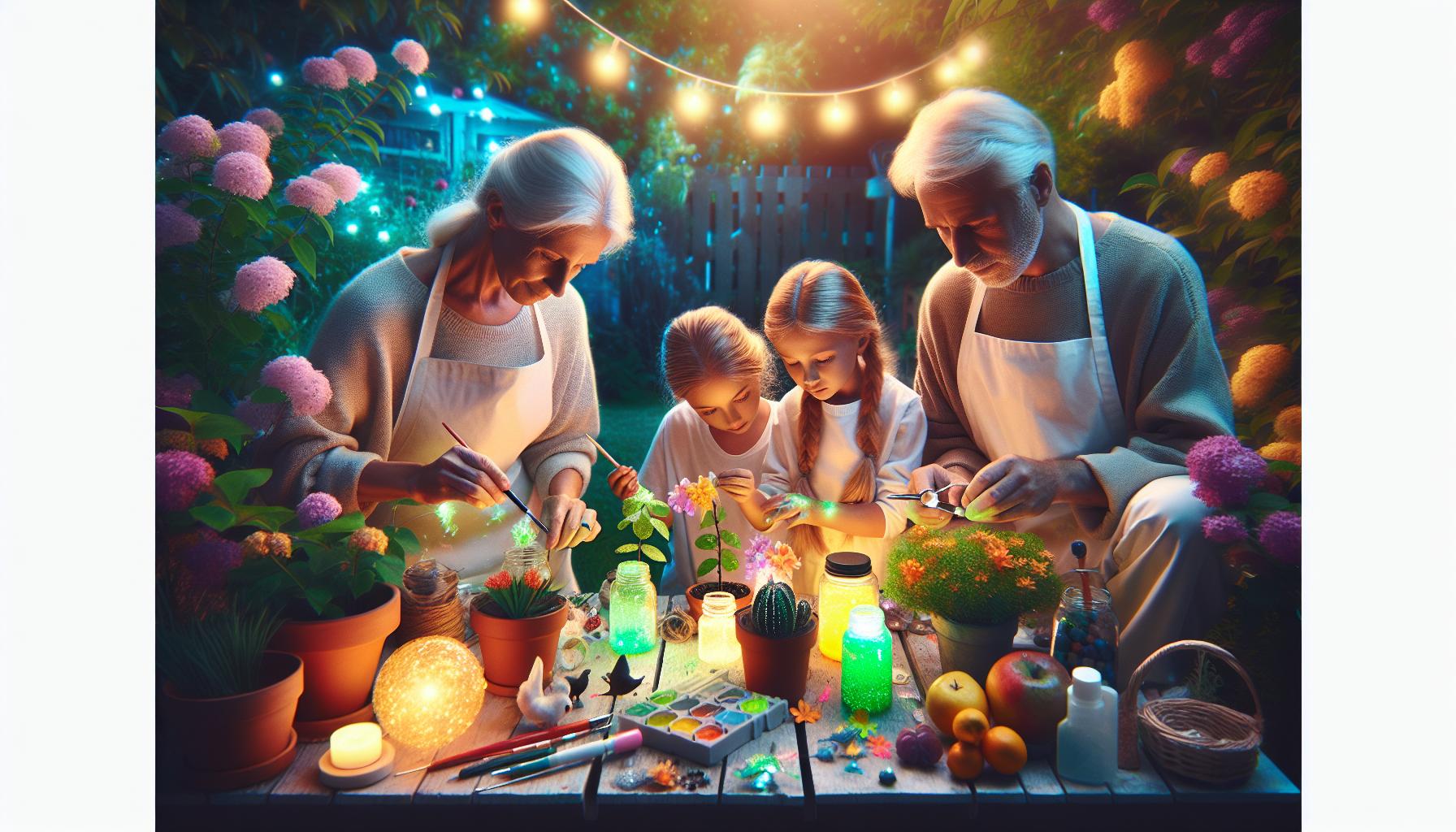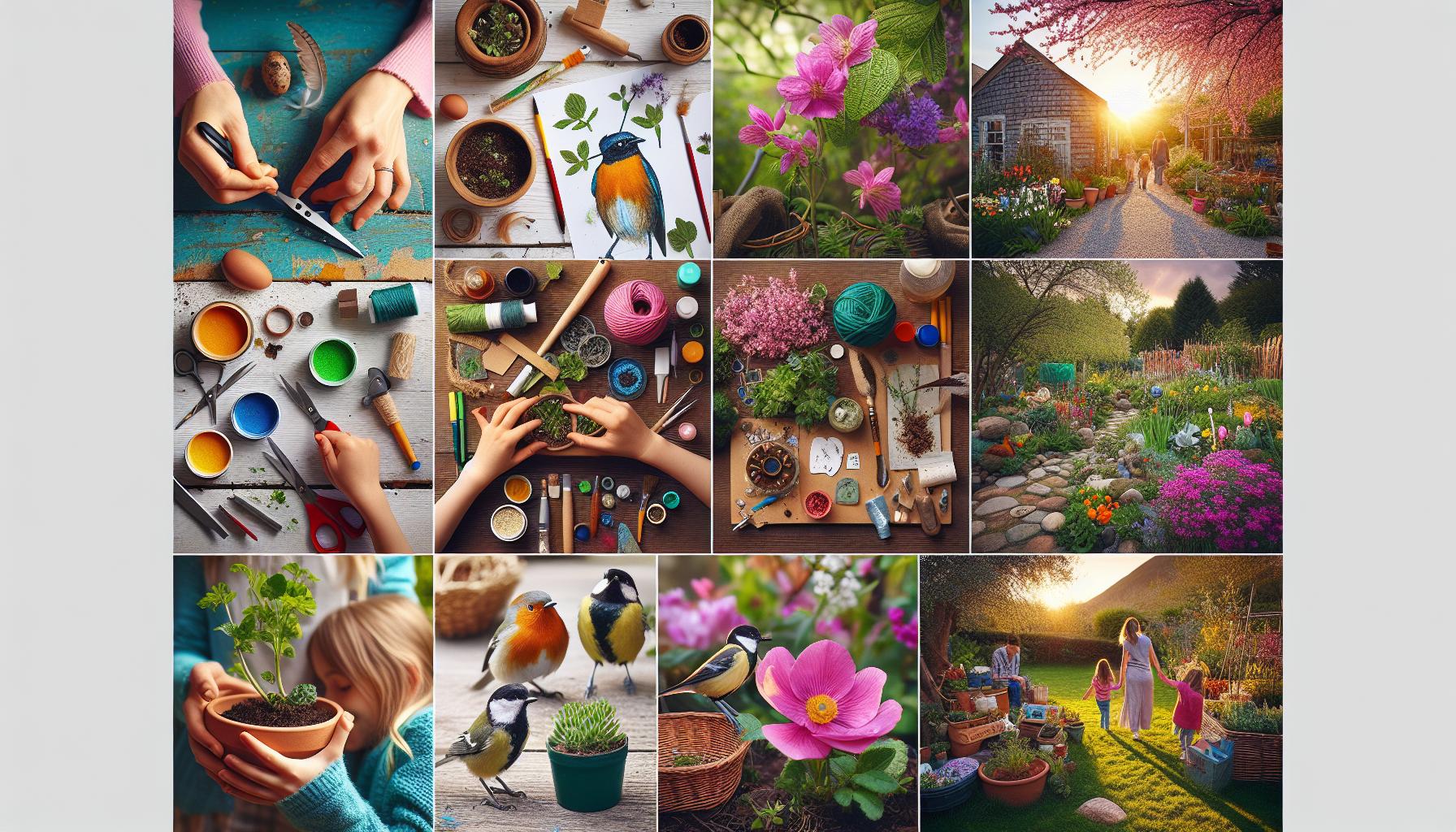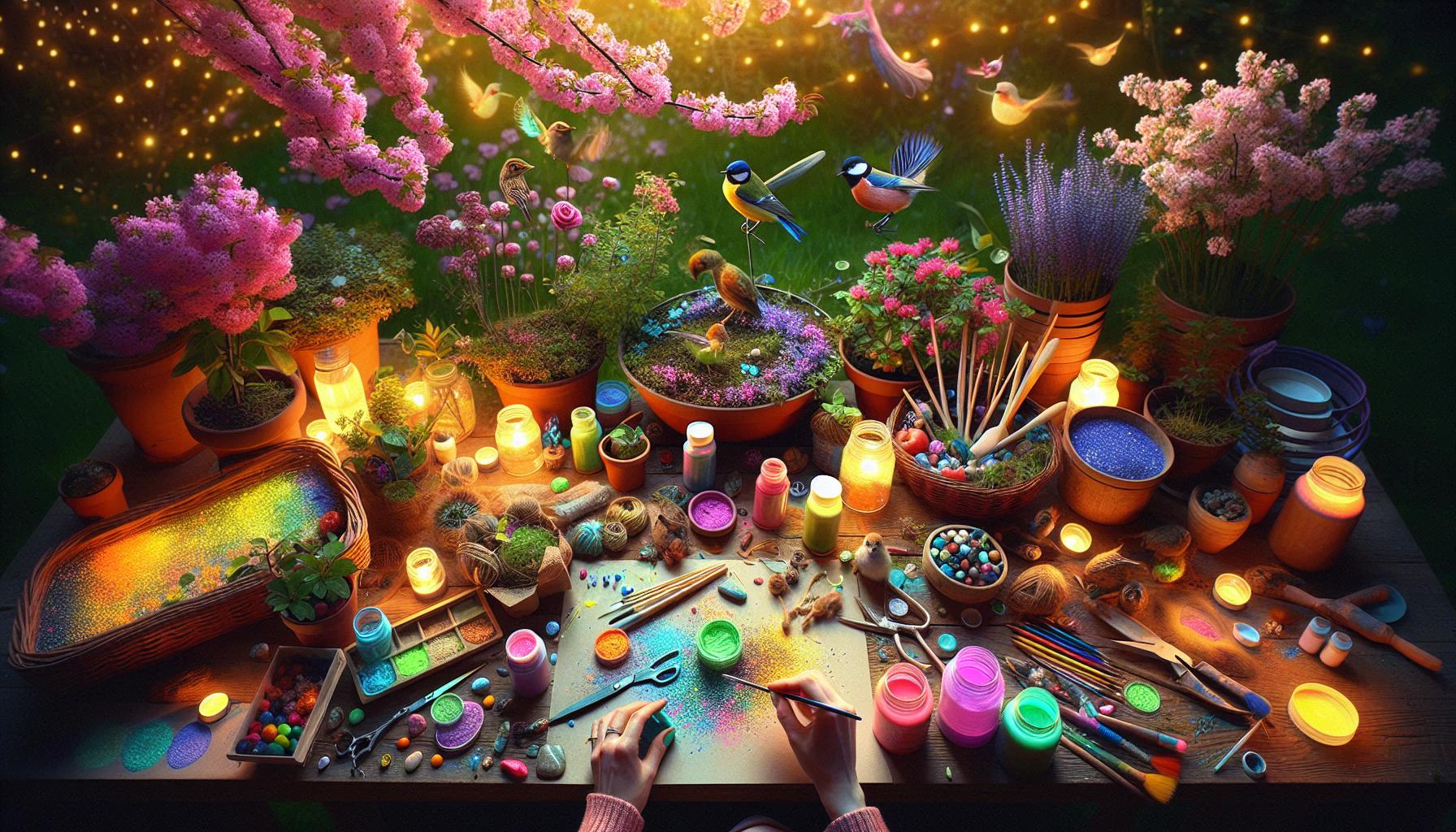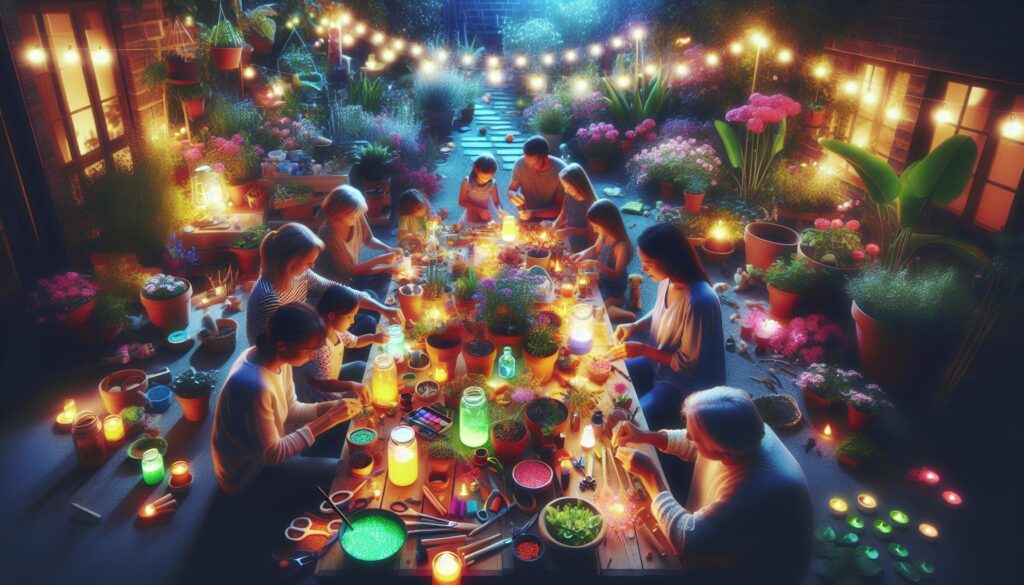DIY Glow-in-the-Dark Garden Ideas: Magical Projects for Nighttime Beauty
Are you ready to transform your garden from a daytime delight into a nighttime wonderland? Look no further! In our guide to “DIY Glow-in-the-Dark Garden Ideas: Magical Projects for Nighttime Beauty,” we’ll illuminate your evenings with creative and whimsical projects that shimmer and shine when the sun goes down. Imagine hosting dinner parties under a canopy of glowing flowers—who needs fairy lights when you can have a glowing garden? Whether you’re a seasoned gardener or a weekend warrior in the backyard, these enchantingly easy DIY ideas will not only jazz up your garden but also have your neighbors green with envy (and perhaps a little jealous of your newfound magical touch).So get ready to unleash your inner garden gnome and prepare for a glow-up that’s anything but ordinary!
Exploring the science Behind Glow-in-the-Dark Materials for Your Garden
Understanding glow-in-the-dark materials begins with the concept of luminescence, which is the ability of a substance to emit light after absorbing photons. The most commonly used materials for DIY garden projects are phosphorescent compounds, such as zinc sulfide and strontium aluminate. Zinc sulfide, while effective, typically glows for a shorter duration and is less bright compared to strontium aluminate, which can glow for several hours after exposure to light. This longevity makes it a favored choice among gardeners looking to create enchanting nighttime displays. By incorporating these materials into various elements of garden design, such as pathways, decorations, and plant pots, you can create a magical ambiance that not only delights the senses but also enhances safety during evening strolls.
When selecting glow-in-the-dark materials for your garden, consider the following factors for optimal results:
- Charge Time: Ensure your materials have adequate exposure to sunlight or artificial light before engaging their glow properties at night.
- Color Spectrum: Different formulations can glow in various colors; green is the most common, while blue and orange offer a unique twist.
- Application Method: Some products are available as paints, powders, or gels, each with distinct usages and effects.
| Material | Glow Duration | Brightness |
|---|---|---|
| Zinc Sulfide | 1-3 hours | Moderate |
| Strontium Aluminate | 6-12 hours | High |
Integrating these materials not only contributes to an aesthetically pleasing garden but also offers practical benefits. For instance, the light emitted can help guide guests through pathways, preventing accidental trips and falls, particularly in darker areas. Furthermore, using glow-in-the-dark techniques allows for creativity and personalization, enabling you to design unique patterns and symbols that resonate with your style. Embrace the magic of science in your garden, and watch as your outdoor space transforms into a radiant wonderland at night.

Selecting the Right Plants to Enhance Your Glow-in-the-Dark Garden
Choosing the right plants is crucial for bringing your glow-in-the-dark garden to life. Start by selecting bioluminescent plants or those that can reflect or absorb light effectively. Some excellent options include:
- Night-Blooming Jasmine – Known for its fragrant blooms that open at night.
- moonflower – Emits a lovely scent and features large, white flower blooms that bloom in the evening.
- Japanese Iris – Offers stunning color contrast in daylight and has an alluring presence at night.
- Phlox – Accentuates your garden with vibrant colors that can absorb moonlight and shimmer in the dark.
In addition to bioluminescent flora, consider integrating plants with reflective or luminescent qualities.To achieve a magical glow, options such as Silver Mound Artemisia and Stachys byzantina can create a shimmering effect under moonlight. You may also incorporate soil amendments that promote phosphorescence in nearby plants. A practical approach is to create a custom planting table to categorize your plant choices:
| Plant Type | Bloom Time | Light Reflection |
|---|---|---|
| Night-blooming Jasmine | Summer | High |
| Moonflower | Summer Eve | Medium |
| Silver Mound artemisia | Spring-Fall | High |

Incorporating Glow-in-the-Dark Paints and Powders into Garden Decor
Transforming your garden into a mystical haven after sunset can be effortlessly achieved by integrating glow-in-the-dark paints and powders into your decor. Begin with planter pots and garden markers, painting them with luminescent designs that will twinkle like stars once the sun goes down.Consider using non-toxic, UV-resistant glow paint for durability. Plus, scatter glow powders in your garden beds or along pathways, ensuring they absorb sunlight during the day and emit a soft glow at night. This technique not only guides guests through your garden but also adds a striking visual appeal that complements the natural beauty of your plants.
For the more adventurous DIY enthusiast, incorporating glow-in-the-dark features into garden sculptures or yard art can create stunning focal points. Utilize clear acrylic or resin infused with glow powders to craft unique pieces that stand out after dark. Another idea is to paint existing birdhouses or garden stakes using glow-in-the-dark paint, making them not just functional but also a part of the nighttime landscape. Harness the power of nature by using solar-powered lights paired with glow paints for a dual effect, where the lights can create a warm atmosphere while the painted elements add a magical twist. these thoughtful enhancements can bring your garden to life in a whole new way, merging functionality with enchanting aesthetics.
Creative Pathway Ideas: Illuminating Your Garden with Glowing Elements
Transforming your garden into a nocturnal wonderland involves using artistic elements that glow in the dark, guiding paths and creating magical spaces. Consider incorporating luminescent stones or pebbles in your garden pathways. These can be easily sourced and applied, giving a subtle glow that can illuminate your way during the night. String lights also bring a whimsical charm; drape them along fences, archways, or pathways to cast a gentle light. To enhance the ambiance further, you might want to use solar-powered garden lights that charge during the day and emit soft glows after sunset. They not only provide illumination but also serve as decorative pieces during the day.
For a more creative touch, think about using glowing paint on fences, pots, or sculptures. You can create eye-catching designs that bring your garden to life after dark.Another elegant design element can be glow-in-the-dark garden art. This can include painted rocks, which can be fashioned into fun shapes or messages. Additionally, here’s a simple comparison table that outlines various glowing options for pathways based on cost, effect, and materials:
| Element | Cost | Effect | Materials |
|---|---|---|---|
| Glowing Stones | Low | Soft Glow | Resin, Pigments |
| String Lights | medium | Warm Ambiance | LEDs, Copper Wire |
| Solar Garden Lights | Medium | bright Spots | Plastic, Glass |
| Glow-in-the-Dark Paint | Low | Custom designs | Acrylic, Phosphorescent |
| Garden Sculptures | High | Artistic Focal Points | Various (Metal, Resin) |
DIY Glow-in-the-Dark Garden Ornaments: Crafting Unique Nighttime Accents
Transforming your outdoor space into a whimsical wonderland can be both fun and rewarding, especially with some creatively crafted ornaments that radiate magical light after the sun sets. Consider making glow-in-the-dark pebbles by spraying ordinary stones with glow-in-the-dark paint. Once they are dry, scatter them throughout flower beds or along pathways to add an enchanting glow. You can also use glass jars to create lantern-like ornaments; fill them with glow sticks or glow powder mixed with resin to create beautifully illuminated centerpieces that will naturally draw the eye as night falls.
Another exciting idea is to create glow-in-the-dark garden stakes using wooden dowels adorned with glow-in-the-dark paint. simply paint the top portion of each stake and insert them into your garden to mark the borders of flower beds or highlight pathway turns. For a more whimsical touch, you can represent your favorite fairy tale characters, like butterflies or fireflies, by cutting out these shapes from sturdy plastic or wood and painting them. Place these in your garden during the day, and watch them come alive at night, guiding you through your garden’s enchanting landscape.
Sustainable Options: eco-Friendly Glow-in-the-Dark Projects for Your Garden
Transforming your garden into a luminous paradise can be both enchanting and eco-conscious. Opt for biodegradable glow-in-the-dark paint, which is frequently enough made from organic materials like plant extracts and minerals.This type of paint not only adds an ethereal glow to your garden but also ensures that harmful chemicals do not leach into the soil. Alternatively, consider glow-in-the-dark stones or pebbles made from recycled post-consumer materials.When scattered around pathways or flower beds, they provide safety and visual appeal while contributing to sustainable gardening practices.
Enhance your outdoor space with solar-powered luminaries, which charge during the day to emit a soft glow at night. These sustainable lighting options can be further improved by using glass jars filled with glow-in-the-dark substances, like phosphorescent powder, to create unique lanterns. For those who enjoy crafting, try making natural luminescent plant markers using reclaimed wood sticks painted with eco-friendly glow paint. Not only are these markers functional, but they also add charm to your garden when illuminated. Here’s a simple overview of sustainable materials to consider:
| Eco-Friendly Material | Benefits |
|---|---|
| Biodegradable Paint | Non-toxic, soil-friendly |
| Recycled Pebbles | Durable, visually striking |
| Solar Lights | Energy-efficient, easy to install |
| Glass Jar Lanterns | Stylish, customizable |
| Wooden Plant Markers | Unique, eco-conscious |
Maintaining and Updating Your Glow-in-the-Dark Garden Aesthetics
To keep your glow-in-the-dark garden looking enchanting, regular maintenance is key. Start by inspecting your luminous elements for any wear or fading.If your glow-in-the-dark paint or materials show signs of deterioration, consider touching them up or reapplying a fresh coat. Replenishing glow materials every season can help maintain vibrancy. Also, cleaning your fixtures and pathways regularly will ensure that they absorb enough light during the day to radiate beautifully at night.
In addition to upkeep, updating your design can breathe new life into your garden. This could involve adding new items like solar-powered glowing lanterns or repurposed household materials that shine in the dark. Consider these creative ideas for your update:
- Incorporate LED lights into your flower beds.
- Create glowing paths using stones painted with phosphorescent compounds.
- Build whimsical structures, like fairy houses, adorned with glow-in-the-dark paint.
remember to be mindful of your plants and surrounding surroundings when selecting new materials. By blending the glow elements with natural aesthetics, you can create a cohesive nighttime oasis.
Showcasing Your Glow-in-the-Dark Garden: Tips for Capturing Its Beauty at Night
to effectively showcase your glow-in-the-dark garden, timing and technique are key. Consider capturing the beauty of your garden during the magical twilight hours, just before dusk sets in completely. This timing allows you to highlight the transition from daylight to the enchanting glow of luminescent elements. Utilize high-quality cameras or smartphones that perform well in low light, and avoid using a flash, which can wash out the glow. Instead, experiment with long exposure settings to let the light capture the essence of your luminous plants and decorations. Think about using the rule of thirds in your framing, placing glowing features off-center to create more engaging compositions.
When it comes to the specifics of what to capture, focus on the intricate details and textures that make your garden unique. Some ideas include:
- Close-ups of luminescent plants,highlighting their unique shapes and colors.
- Wide-angle shots that encompass the entire garden to reflect the harmony of light and space.
- Creative night sculptures or installations integrated with glow-in-the-dark elements.
Additionally, consider setting up ambient lighting, like string lights or lanterns, to complement the glow-in-the-dark effects while not overpowering them. For a more artistic view, try using moving light sources or filters that enhance the glow, creating an ethereal atmosphere akin to a fantastical realm. By blending these techniques, your photographs will not only document the whimsical aspect of your garden but also invite viewers into a dreamlike experience.
Faq
What materials are ideal for creating glow-in-the-dark elements in my garden?
When considering materials for your glow-in-the-dark garden projects, several options stand out in terms of effectiveness and aesthetic appeal. Glow-in-the-dark paint is one of the most popular choices, allowing you to transform existing garden items such as planters, fence posts, and rocks into luminous night-time features. Products like Rust-Oleum Glow-in-the-Dark spray Paint are specially designed for outdoor use, ensuring durability and a bright glow.Additionally, glow-in-the-dark resin can be used to create unique garden sculptures or ornaments. This material not only illuminates but can also be molded into various shapes,making it perfect for personalized garden art.Another innovative approach is using fluorescent gravel or pebbles, which can be scattered around pathways or flower beds. These absorb sunlight during the day and emit a soft glow after dark, enhancing nighttime visibility while adding an enchanting atmosphere.
don’t overlook solar-powered lights that feature glow-in-the-dark components. These devices harness sunlight during the day; when the sun sets, they provide illumination while also contributing glow-in-the-dark accents to your landscape.
How can I incorporate glow-in-the-dark plants into my garden design?
Incorporating glow-in-the-dark elements into your garden can go beyond just using materials; you can also embrace plants that glow in the dark or appear luminescent. While there are currently no truly nocturnal plants that glow naturally, certain species, such as Ipomoea batatas (‘Sweet potato Vine’), can exhibit luminescence under specific conditions. Innovative gardeners may also experiment with bioluminescent algae or mushrooms, which some have successfully integrated into their designs.
To enhance this effect, consider layering your garden. Place taller plants in the back to create depth, and use shorter, lighter varieties in front.This not only provides a visual contrast but also allows the glow to be visible without being obstructed.
Additionally, strategically placed lighting can complement these plants. For example, using a small LED spotlight can highlight a glowing plant during the evening, drawing attention to its unique features. Remember to choose plants that thrive in your climate and soil type, ensuring they’ll flourish.
what are some simple DIY glow-in-the-dark garden projects to start with?
If you’re new to DIY and looking for simple yet effective projects, there are several glow-in-the-dark options that can enhance your garden’s charm. One straightforward idea is glow-in-the-dark painted rocks. By simply applying glow-in-the-dark paint to rocks, you can create eye-catching path markers or decorative accents. This project is not only easy but also provides an excellent prospect for creativity; you can paint thematic designs or even simple patterns.
Another fun project involves making glow-in-the-dark garden markers for your plants. Use wooden stakes and decorate them with glow paint or attach glow-in-the-dark stickers.This way, you not only classify your plants but also add a whimsical touch that’s visible after dark.
Lastly, consider creating a glow-in-the-dark birdbath. With the use of resin and some glow powder, you can transform a simple birdbath into a stunning focal point in your garden that attracts both birds and the eye.
Are there any safety precautions to consider when using glow-in-the-dark materials?
Absolutely! While glow-in-the-dark materials can add magic to your garden, it’s crucial to understand safety considerations. First and foremost, confirm that all products used are labeled as non-toxic, especially if you have pets or small children.Many glow paints are designed for safety, but those with high levels of chemicals can pose risks.
When working with resin or other materials that may emit fumes, ensure good ventilation in your workspace. Using a ventilated area or even working outdoors can significantly reduce inhalation exposure. Wearing gloves and a mask during application can further shield against irritation and contact with skin.
Lastly, consider natural wear and tear. Some glow-in-the-dark materials might fade or degrade when exposed to weather conditions.Regularly check items for damage to ensure they do not become sharp or unsafe over time. Keeping your garden stunning should not come at the expense of safety.
How do I maintain my glow-in-the-dark garden features?
Maintaining your glow-in-the-dark garden features is essential for ensuring their longevity and effectiveness. The first step is to routinely clean the items to prevent dirt or debris from diminishing their glow. A simple wipe down with a damp cloth can keep items looking vibrant.
Additionally, it’s crucial to ensure that glow materials are charged adequately. Many glow-in-the-dark products require exposure to sunlight or other light sources to recharge. Regularly check that any illuminated items are positioned to receive enough light during the day. If you use glow paint or resin, you might consider reapplying them every couple of years or whenever you notice a decline in brightness.
Be mindful of the seasons as well. In colder months, items like painted rocks or resin sculptures may need to be brought indoors or protected from freezing conditions, which can crack or damage the materials. Planning for seasonal care extends the life of your decor while maintaining the enchanting nighttime atmosphere you’ve created.
Where can I find inspiration for glow-in-the-dark garden designs?
Finding inspiration for glow-in-the-dark garden designs can be an enjoyable part of the creative process. Start by exploring social media platforms like Pinterest and Instagram, which are treasure troves of DIY ideas. Searching terms like “glow-in-the-dark garden” can yield a multitude of images showcasing projects from various gardeners around the world, providing practical examples and new concepts.
Another great resource is gardening blogs and websites dedicated to DIY gardening. These platforms frequently enough feature articles on similar projects, complete with step-by-step tutorials and helpful tips. additionally, you might consider joining local gardening clubs or online forums where enthusiasts share their experiences and ideas—these community interactions often lead to unique inspiration influenced by personal projects.
do not underestimate local nurseries and gardening centers. Sometimes they showcase garden displays that mix conventional gardening with creative themes. Visiting these spaces may spark your imagination while allowing you to see how glow-in-the-dark elements can be harmoniously integrated into your garden vision.
The Conclusion
As you embark on your journey to illuminate your garden with DIY glow-in-the-dark projects, remember that creativity knows no bounds. the magic of nighttime beauty is not just about aesthetics; it’s about transforming your outdoor space into a realm of wonder and tranquility. From luminous pathways to enchanting fairy light features, each project offers a unique opportunity to express your style while enhancing the functionality of your garden.
By incorporating eco-friendly materials and techniques, such as photoluminescent paints and recycled glass, you not only contribute to environmental sustainability but also create stunning visual effects that will captivate your guests and family alike. As studies show, well-lit gardens can enhance safety and increase property value, making your glow-in-the-dark endeavors a wise investment.
So gather your supplies, embrace your inner artist, and let your garden shine as a testament to your creativity. With the right approach and a little ingenuity, your outdoor space can come alive at night, providing a serene escape that reassures and inspires. Happy gardening!



